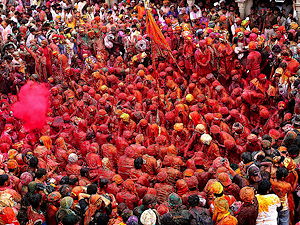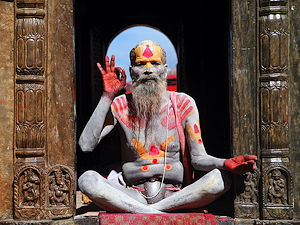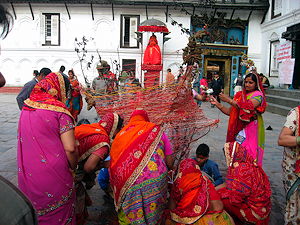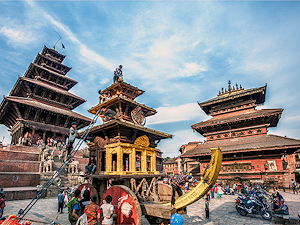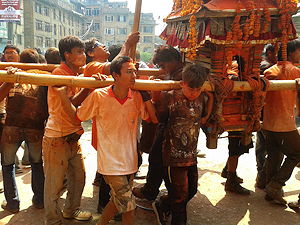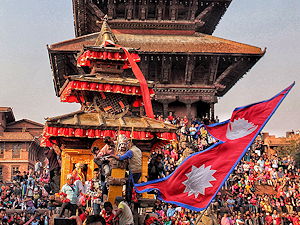February/March: Holi
Holi, or the Festival of Colours or Festival of Love, is held in Kathmandu each February or March.
It is best known for riotous scenes of revellers throwing water or coloured powder over one another. This is done in celebration of the end of winter and as a reminder of the cooling monsoon rains to come (usually in July or August).
Holi is a Hindu festival, celebrated at Phalguna Purnima (Full Moon) at the end of winter's last lunar month. It lasts 24 hours: from sunset on the day before the festival (when Holika bonfires are lit around the country, and people congregate to dance and sing) until sunset of the day of the festival.
Be sure to wear old clothes if you are going out: you will not be asked before you are pelted.
Whilst there are usually a few complaints about some locals being overly enthusiastic, the overwhelming majority of people get into the spirit of the festival.
In 2020, Holi will be celebrated on 9-10 March.
April: Bisket Jatra
Bisket Jatra is Nepali New Year, celebrated most raucously in Bhaktapur.
The centrepiece of the festival, which takes place in mid-April, is a huge golden chariot which is carried around the town until it reaches the Khalna Tole.
The chariot, carrying images of the god Bhairab, stops on its journey to enable a tug-of-war to take place between the inhabitants of the east and west sides of Bhaktapur.
Once at Khalna Tole, a 25 metre-high phallic symbol is installed on a stone platform; it is demolished the next day in the aftermath of yet another tug-of-war!
The public celebrations are accompanied by private celebrations amongst the population: families convene for up to four days of feasting, with family elders placing tilaka marks (using red tikka powder) on the foreheads their juniors.
The next Bisket Jatra will be held 13 April 2020.
September: Indra Jatra
September sees the end of the monsoon season, warm temperatures and lush green everywhere.
It also sees the Indra Jatra festival (literally, procession of the Lord of the Rain), which combines homage to Indra with the annual appearance of Kathmandu's living goddess.
Indra is one of the chief deities of the Hindu religion, the god of rain and thunderstorms, who wields a lightning rod and rides a white elephant called Airavata.
Kathmandu's living goddess is a young girl chosen from the Kathmandu valley, who lives in the Kumari Bahal temple on Durbar Square. The selection process is rigorous: the child, aged between 2 and 4 years old, can never have had an injury that has drawn blood, and must pass the '32 perfections test' (which assesses things such as the child's horoscope, eye colour and teeth shape).
The festival lasts eight days, with most events starting or ending at the Hanuman Dhoka in Kathmandu. It is here that a ceremonial pole (the Linga) is erected, in a ceremony in which the deity Akash Bhairava is represented by a massive mask (pictured).
In 2019, Indra Jatra was held from 10 to 17 September. 2020 the eight-day long Indra Jatra festival falls on September 1st.
October: Dashain
October is peak tourist season, with the skies clear and temperatures comfortable for trekking.
It is also the month in which Nepal’s most important festival is held, the 15-day long Dashain celebration (2018: 16 - 21 October; 2019: 5-10 October; 2020: 26-31 October).
Held during the bright lunar fortnight and ending on the day of the full moon, the Dasain festival celebrates the goddess Durga. Durga, meaning the invincible, is the Goddess of Victory of Good over Evil, and is the most popular incarnation of Devi; her weapons include the trident, discus and lasso.
Durga’s victory over the buffalo demon Mahisasura is symbolised throughout the country by the sacrificing of animals on a vast scale. The sacrifices, of buffalos and goats in particular, are designed to appease the goddess; Nepal Airlines even sacrifices goats on the runway of Kathmandu airport.
Nepalis also erect hundreds of bamboo swings at the entrances to villages. Called ‘ping’ in Nepali, these structures can exceed 20 feet in height and are not for the feint-hearted.
October / November: Diwali
Diwali (aka Deepawali or the Festival of Lights) is the second most important Hindu festival in Nepal.
Celebrated over five days, the festival starts with the honouring of animals such as crows, dogs, cows and bullocks. On the third day, held on the darkest night of the lunar month, the Goddess of Wealth visits every home that has been suitably lit for her presence.
The whole nation is, accordingly, illuminated with small clay lamps filled with oil and candles. The festival is also marked by the bursting of firecrackers, the giving of sweets as gifts and the placing of tikas on foreheads.
This year, the third (main) day of Diwali celebreations will be held on 14 November 2020. (2018: 7 November; 2019: 27 October).
November: Mani Rimdu
November is another great trekking month, with clear skies and temperatures only starting to drop as December approaches.
Tengboche Monastery (pictured), at 3867 metres, is the centre of Nepal’s Sherpa community. And it is here that the Mani Rimdu festival takes place.
There are three aspects to Mani Rimdu. First, the blessing of red pills during the festival, which are then distributed to those who attend.
Secondly, the creation of a mandala diagram from coloured sand brought from the nearby hills; the diagram takes four days to draw and is the centre point for the next 10 days of the festival. It is removed at the end of the festival, with the monks conducting a fire rite to dispel harm from the world.
Finally, Rimdu involves the monks of Tengboche Monastery performing a masked dance.
The Mani Rimdu Festival for the year 2019 was celebrated at the Tengboche Monastery from 12th November to 15th November. 2020 is still TBD.
December: Kathmandu International Mountain Film Festival (KIMFF)
The Kathmandu International Mountain Film Festival takes place in in early December each year.
The event aims to celebrate the various aspects of mountain life, be they sporting, cultural, environmental or otherwise. Films made in the last three years are eligible for entry, with cash prizes awarded to the winning entries. The festival includes a range of screenings, lectures and workshops. Following the festival, the winning entries are screened in various other towns in Nepal.
Past winners of the KIMFF best film prize include 'Who Will Be A Gurkha' in 2012 and the French Film 'Les Jours de Tarap' last year.
The Kathmandu International Festival is a member of the International Alliance for Mountain Film, whose members include the Canadian Banff Mountain Film Festival and the Italian Trento Film Festival.
In 2016, the Festival took place between 10 and 14 December so that it coincided with International Mountain Day (a UN event aimed at promoting sustainable development in the mountains). The best film in the international category was awarded to Susan Gluth for 'Urmila- My Memory is My Power'.
KIMFF will be held between Tue, 10 Dec 2019 – Sat, 14 Dec 2019.
